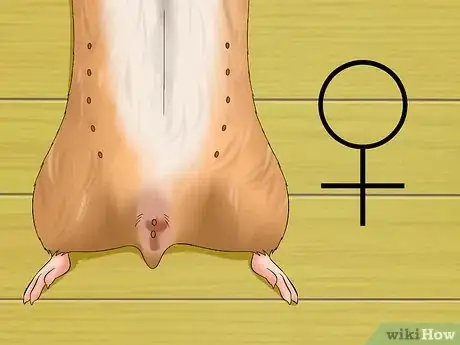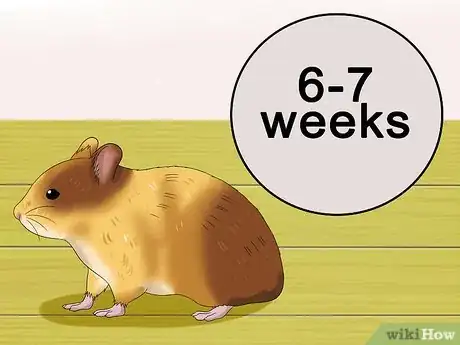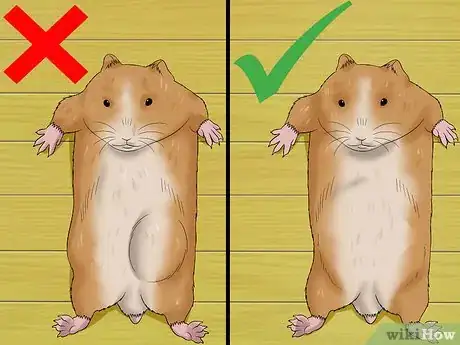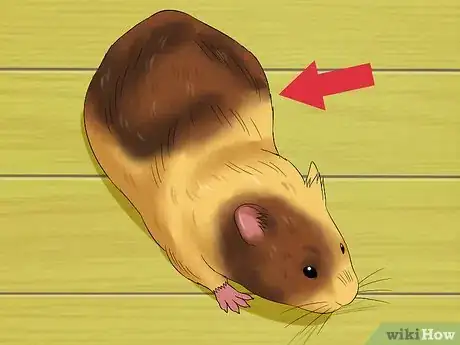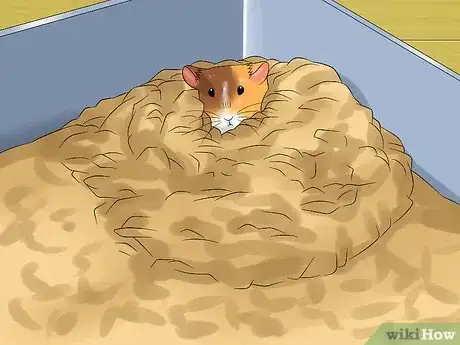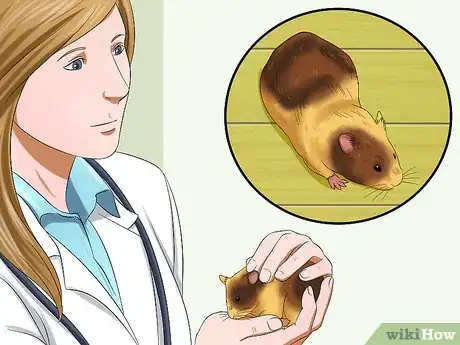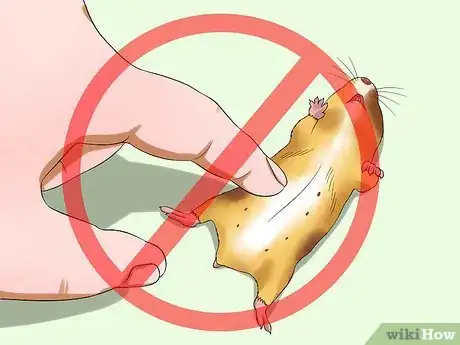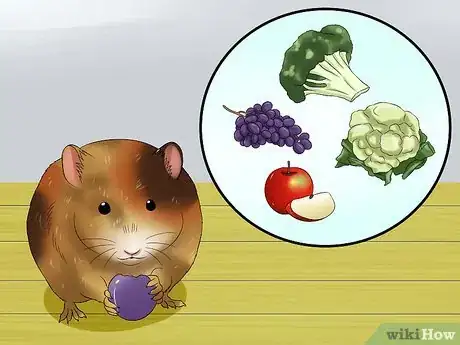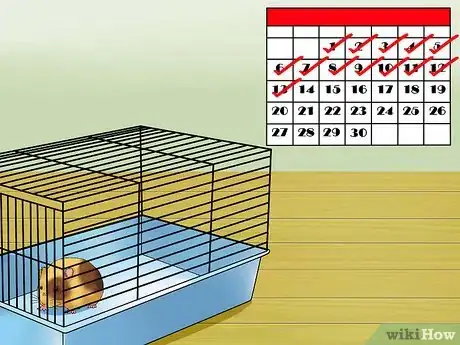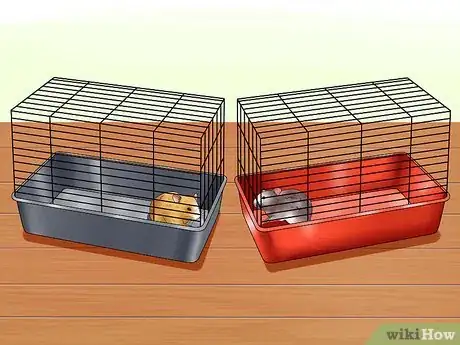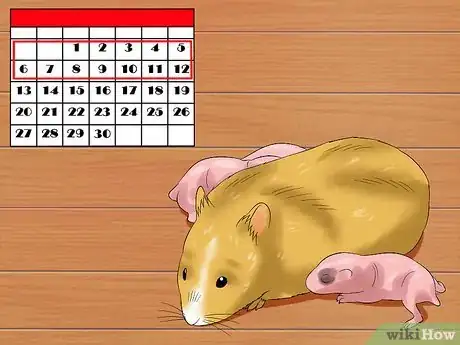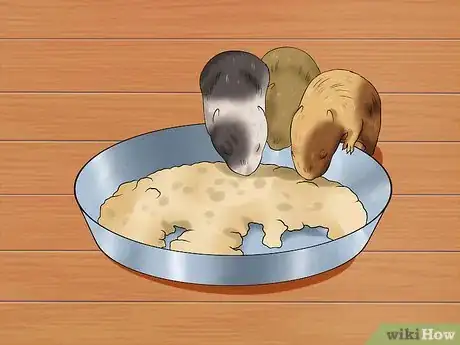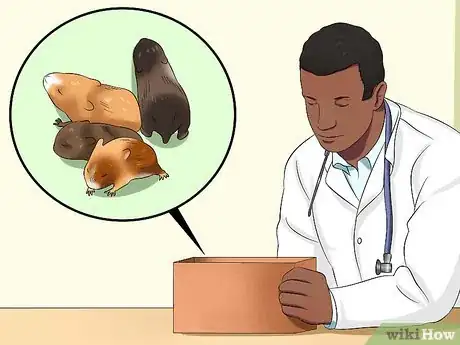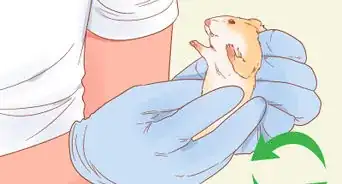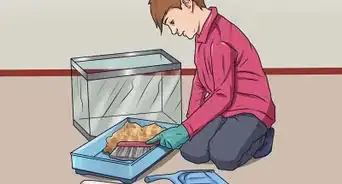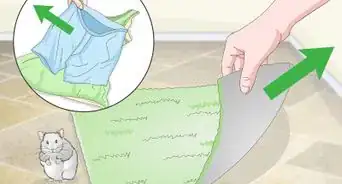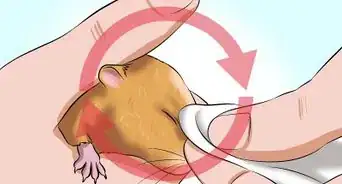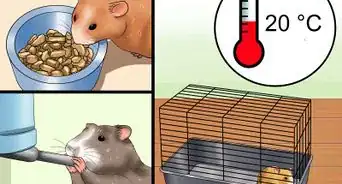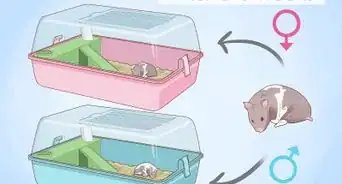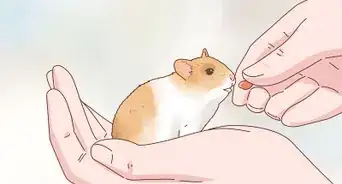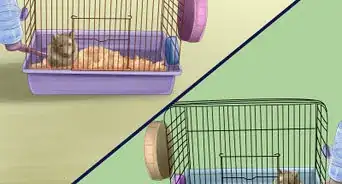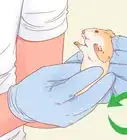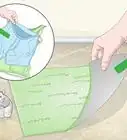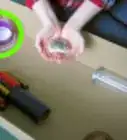This article was co-authored by Pippa Elliott, MRCVS. Dr. Elliott, BVMS, MRCVS is a veterinarian with over 30 years of experience in veterinary surgery and companion animal practice. She graduated from the University of Glasgow in 1987 with a degree in veterinary medicine and surgery. She has worked at the same animal clinic in her hometown for over 20 years.
wikiHow marks an article as reader-approved once it receives enough positive feedback. This article has 14 testimonials from our readers, earning it our reader-approved status.
This article has been viewed 498,694 times.
You may have noticed your hamster acting differently than normal over the past several days. One of the possible reasons behind her changes in behavior is that she’s pregnant. By knowing what signs to look for and how to handle your hamster, you can both identify if she’s pregnant and help ensure the safety of the new baby hamsters.
Steps
Identifying a Pregnant Hamster
-
1Identify the sex of your hamster. It might seem obvious, but like humans, only a female hamster can become pregnant. Most people will already know the sex of their hamster, but just in case you don’t, visit How to Sex a Hamster for more information on determining whether or not your hamster is female.
- Gently scruff your hamster (hold it by the loose skin just above the shoulders firmly but without pinching), and turn the animal gently over to check its sex. Males will have prominent testicles just around the tail that make their rumps bulge, whereas females lack this and instead have much more prominent pairs of nipples on the underside.
- If you’ve always simply assumed that your hamster is female because it had a typically female name when you bought it, then you should probably check.
- Note that if you think your hamster is pregnant due to a swollen belly, then she’s already to a part of the pregnancy where you should refrain from touching her due to the stress handling causes in the late stages of pregnancy.
-
2Note if she has been around any male hamsters. The average length of a pregnancy for a hamster is 15-21 days, so your hamster would need to have been housed with a male hamster within roughly the last three weeks in order to be pregnant.[1] If she hasn’t had company in more than four weeks, then she cannot be pregnant.Advertisement
-
3Note the age of the hamster. Hamsters can start breeding from as young as 6-7 weeks of age.[2] The only way to rule out pregnancy due to sexual immaturity of the hamster is if she is even younger than six weeks.
- This also means you need to be careful storing hamsters from a litter together once they approach six weeks old because they will start mating together. This includes any male hamsters with the mother.
-
4Rule out illness. A swollen belly alone isn’t nearly enough to identify a pregnant hamster. A swollen belly can actually be a sign of another illness or condition affecting your hamster. Possible illnesses that may result in a pregnant appearance include:[3]
- Pyometra, which is a womb infection that distends the hamster’s tummy with pus
- Enlarged internal organs such as the liver or spleen, which are likely the result of cancer
- Heart disease, which can lead to the accumulation of fluid in the belly
- Bowel problems distending the belly with waste due to improper food digestion
- You may notice other signs of sickness with several of these, including increased thirst (her drinker may empty faster than usual), decreased appetite (note if you’re filling her food bowl less often), and loss of body fat (usually over the ribs).
-
5Look for a swollen belly. This may have been your first indication that your hamster is pregnant, but in case it wasn’t, watch to see if her tummy begins to grow. If she’s eating, drinking, and exercising as normal and has had a chance to mate, then the swollen belly is a very probable sign she is pregnant.
- Note that a hamster likely won’t “show” her pregnancy until the final third of the gestation (day 10+), so you may be less than a week away from her delivering the litter by the time you notice the bump.[4]
- She will also have enlarged nipples around the same time her belly swells. However, enlarged nipples on a small hamster can be difficult to see, so don't worry if you can't spot them beneath the fur.[5] Handling her during the late stage of her pregnancy will upset her, though, so don't pick her up to look at the nipples.
-
6Watch for nest building. A pregnant female will want to build a nest late in pregnancy, so collecting bedding material together and taking it to a secluded place in the cage can be a hint of pregnancy.[6]
-
7See if she hoards food. The pregnant female may start to eat marginally more than usual, and also hide more food away, perhaps in the nest. Obviously, in itself this does not confirm pregnancy but it does help to build the overall picture.
-
8Look for signs that she’s about to go into labor. Your hamster may become even more frantic in the very late stages of her pregnancy. Signs of imminent birth include becoming restless and alternating between eating, grooming, and nest building. She may also hiss at you if you reach in.
-
9Take your hamster to the vet. If all else fails, your vet will be able to help you identify whether or not your hamster is pregnant. However, your vet will also likely warn you that even being handled by a professional animal care provider can still lead to the environmental stress that may cause the mother to abandon or cannibalize the litter.
- If the swollen belly lasts longer than 7-10 days without your hamster giving birth (or if she doesn’t exhibit any of the other common behavioral traits for a pregnant hamster in this time), then take her to the vet anyway since she may be presenting symptoms of an illness rather than pregnancy.
Ensuring the Safety of the Litter
-
1Do not ever touch the mother’s belly to try to feel the babies. Pregnant females are extremely sensitive to disruption, and if they feel stressed, they are highly likely to harm the babies when they are born. Having a human feel her belly is definitely stressful to a female hamster, so it puts the health of the babies at risk.
-
2Feed the mother a nutritious diet during pregnancy. Be extra sure that your hamster's diet is nutritionally sound to ensure the health of the babies. Feed a diet she is familiar with, as sudden changes could upset her stomach. However, an ideal diet is pelleted rat or mouse chow since she cannot selectively eat around the healthy (but less tasty) bits.
- Very small quantities of milk and cheese provide calcium for the done development of the litter, and they also help the mother in lactation once the babies are born.[7]
- As an additional protein source, you can feed your hamster moderate amounts of hard-boiled egg, nuts, barley, and oats.[8]
- Though you must provide them in very small amounts (or risk gastrointestinal problems), pregnant hamsters can benefits from the additional vitamins and minerals found in fruits and vegetables, such as broccoli, cucumber, cauliflower, apples, grapes, bananas, and strawberries.[9]
-
3Leave the mother alone starting around day thirteen after mating. Female hamsters like to be left completely alone at least a couple of days before giving birth. This means that by day thirteen after mating, you should not even interfere with her cage or bedding. Be as careful as possible when putting fresh food in with her as well. Failure to do this could lead to cannibalization of the newborn babies.[10]
- Since you may not have any idea when the mother mated, consider that she usually starts “showing” the pregnancy around day ten after mating.[11]
-
4Keep other hamsters in separate cages. In addition to a stressed mother hamster potentially cannibalizing her litter, other hamsters kept in the same cage can lead to the same result. To ensure the safety of the baby hamsters, begin housing other hamsters you have in separate cages as soon as you know for sure that the mother is pregnant.
- If hamsters kept in the same cage begin fighting despite usually getting along, this is also a sign that one of them may be pregnant if it appears in association with some of the other signs.
-
5Do not handle the babies for two weeks. During the first two weeks, the mother will recognize her babies by scent. If you handle the baby hamsters, even by accident, the mother may attack them. It is safe to begin handling them after roughly two weeks.
- This also includes accidentally transferring your scent from other handling of the cage. Don’t try to clean the cage during this period.
-
6Reposition sipper tubes. Remember that your water sipper is probably placed at a height for your adult hamster. Reposition it if you need to so that the litter can also reach it to drink.
-
7Start placing solid food for the babies at 7-10 days. Though they won’t be fully weaned until around three weeks, you can start placing solid food in the cage after 7-10 days. You can use a standard pellet diet, but soak the pellets in water first to soften them for the litter.
-
8Take the litter to the vet immediately if you notice the mother abandoning them. Especially if it’s the mother’s first litter, she is more likely to abandon or cannibalize the litter due to environmental stressors. If this is the case, separate the mother from the litter immediately and take them to the vet. He or she will likely suggest a local rescue or animal hospital capable of helping care for the abandoned litter.
Expert Q&A
Did you know you can get expert answers for this article?
Unlock expert answers by supporting wikiHow
-
QuestionDoes the mom have to get cut open to give birth?
 Pippa Elliott, MRCVSDr. Elliott, BVMS, MRCVS is a veterinarian with over 30 years of experience in veterinary surgery and companion animal practice. She graduated from the University of Glasgow in 1987 with a degree in veterinary medicine and surgery. She has worked at the same animal clinic in her hometown for over 20 years.
Pippa Elliott, MRCVSDr. Elliott, BVMS, MRCVS is a veterinarian with over 30 years of experience in veterinary surgery and companion animal practice. She graduated from the University of Glasgow in 1987 with a degree in veterinary medicine and surgery. She has worked at the same animal clinic in her hometown for over 20 years.
Veterinarian
-
QuestionWhen can I give away the babies?
 Pippa Elliott, MRCVSDr. Elliott, BVMS, MRCVS is a veterinarian with over 30 years of experience in veterinary surgery and companion animal practice. She graduated from the University of Glasgow in 1987 with a degree in veterinary medicine and surgery. She has worked at the same animal clinic in her hometown for over 20 years.
Pippa Elliott, MRCVSDr. Elliott, BVMS, MRCVS is a veterinarian with over 30 years of experience in veterinary surgery and companion animal practice. She graduated from the University of Glasgow in 1987 with a degree in veterinary medicine and surgery. She has worked at the same animal clinic in her hometown for over 20 years.
Veterinarian
Warnings
- Do not scruff your hamster too tightly or you may cause its eyes to pop out.⧼thumbs_response⧽
References
- ↑ Handbook of Rodent and Rabbit Medicine. Laber-Laird. Publisher: Pergamon
- ↑ Handbook of Rodent and Rabbit Medicine. Laber-Laird. Publisher: Pergamon
- ↑ Handbook of Rodent and Rabbit Medicine. Laber-Laird. Publisher: Pergamon
- ↑ Handbook of Rodent and Rabbit Medicine. Laber-Laird. Publisher: Pergamon
- ↑ Handbook of Rodent and Rabbit Medicine. Laber-Laird. Publisher: Pergamon
- ↑ Handbook of Rodent and Rabbit Medicine. Laber-Laird. Publisher: Pergamon
- ↑ http://animals.mom.me/food-pregnant-hamster-2041.html
- ↑ http://animals.mom.me/food-pregnant-hamster-2041.html
- ↑ http://animals.mom.me/food-pregnant-hamster-2041.html
About This Article
Female hamsters can become pregnant starting when they are around 6-7 weeks old. If your hamster is the right age and has spent time around male hamsters, keep an eye out for signs of pregnancy, such as a swollen belly and enlarged nipples. You might also notice her piling up bedding to create a nest, or hoarding more food than usual. If your hamster’s pregnancy is advanced, she may act agitated and restless. If you notice that your hamster is acting ill or that her belly is still swollen after 7-10 days, take her to the vet to rule out an illness. However, be careful handling a hamster that may be pregnant, since any extra stress could cause complications or encourage her to abandon her litter. For more help from our Veterinary co-author, like how to keep your hamster’s litter safe, read on!
